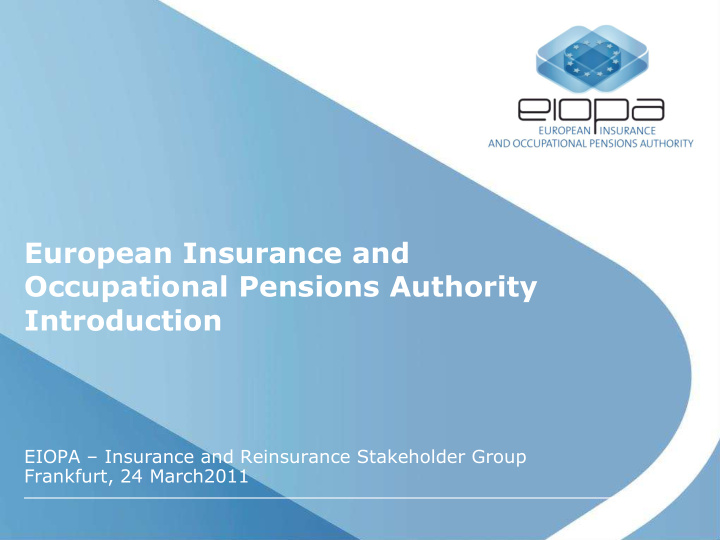



European Insurance and Occupational Pensions Authority Introduction EIOPA – Insurance and Reinsurance Stakeholder Group Frankfurt, 24 March2011
Background & Timeline • Financial crisis in 2007 and 2008 prompted a review of supervisory model • November 2008 : European Commission mandated a High Level Group, the Committee of Wise Men, chaired by Jacques de Larosière to make recommendations on how to strengthen European supervisory arrangements • February 2009 : De Larosière Report published: Committee of Wise Men recommends reforms to the structure of o supervision of the financial sector in the European Union Committee also concluded that a European System of Financial o Supervisors should be created and recommended the creation of a European Systemic Risk Council • March & May 2009 : European Commission proposed to put forward draft legislation and details about its possible architecture. 2
Background & Timeline • 19 June 2009 : European Council confirmed that a European System of Financial Supervision (ESFS) should be established. • 22 September 2010: European Parliament approved legislation allowing establishment of European Supervisory Authorities (ESAs) • 16 December 2010 : EIOPA Regulation enters into force • 1 January 2011 : EIOPA established • 10 January 2011 : first meeting of the Board of Supervisors formalizes EIOPA’s establishment. Election of the Management Board and acting Chair validates the establishment of EIOPA • 1 March 2011 : Chairman takes office • March 2011: Expected EP confirmation of Executive Director 3
Main Objectives • Better protecting consumers, rebuilding trust in the financial system • Establishing a European single rule book • Greater harmonisation and coherent application of rules • Ensuring a high, effective and consistent level of regulation and supervision • Foster supervisory convergence across the EU • Promote coordinated EU supervisory response • Strengthening oversight of cross-border groups 4
Main Responsibilities • Protection of policyholders, pension scheme members and beneficiaries • Support financial stability, transparency of markets and financial products • Monitor and identify trends, potential risks • Independent advisory body to the EU institutions in the area of insurance, reinsurance and occupational pensions • Prevent regulatory arbitrage, guarantee level playing field, strengthen international supervisory coordination • Foster dialogue and cooperation with supervisors outside the EU and international organisations 5
Legal Status • Legal personality as well as administrative and financial autonomy • Autonomous budget with revenues mainly from obligatory contributions from national supervisory authorities and EU’s General Budget • All CEIOPS existing tasks and competences including the continuation of ongoing work and projects • Accountable to the European Parliament and the Council of the European Union 6
Powers • Develop draft regulatory and implementing technical standards • Issue guidelines and recommendations on the application of EU law to ensure consistent application of EU law • In certain cases, require national supervisory authorities to take specific actions to remedy an emergency situation • Settle disagreements in cross-border situations between authorities, including within colleges of supervisors • Participate in colleges of supervisors 7
Composition of EIOPA An Overview European System of Financial Supervision European Systemic Risk Board (ESRB) – macro view Non-voting: ECB Council (with Representative of the insurance and Chairs of EBA, European + national supervisor(s) per + + securities alternates EIOPA & ESMA Commission Member State + EFC where necessary) President European Supervisory Authorities and National Supervision – micro view European European Securities and Markets European Banking Authority Authority Insurance and Occupational (EBA) (ESMA) Pensions Authority (EIOPA) National Insurance and National Securities National Banking Pension Supervisors Supervisors Supervisors 8
Composition of EIOPA • Management o Board of Supervisors: principal decision making organ, composed of: - Chairperson (non-voting) - relevant competent authority in each Member State - representative of the European Commission, ESRB, EBA and ESMA to participate as observers (non-voting) o Management Board ensures that EIOPA carries out its mission and performs the tasks assigned to it. Composed of: - Chairperson of EIOPA - Six representatives of national supervisory authorities - representative of the European Commission o Chairperson - full-time Chairperson, appointed by the Board of Supervisors and confirmed by the European Parliament within one month after selection by the Board of Supervisors o Executive Director - management of EIOPA • Joint Committee of European Supervisory Authorities - coordinates activities of the European Supervisory Agencies (ESAs) and coordinates functions in relation to financial conglomerates and other cross-sectoral issues • Board of Appeal Gives parties right to appeal decisions of ESAs. Joint body of ESAs, independent from their administrative and regulatory structures. Composed of six members and six alternates 9
Composition of EIOPA A Simplified Example Board of Supervisors Board of Appeal Chairperson Management Board appoints Executive Director EIOPA Staff 10
EIOPA “Inside” • By 1 April 2011, 37 headcount up from 16 in 2009 • 19 nationalities - 28 temporary agents, 3 contract agents and 6 secondees (national contract), • Target headcount 40-50 in 2011, and roughly 100-120 by 2013/2014 • Experts on drafting technical standards, with supervisory background for colleges, supporting staff 11
Tools • Colleges of supervisors • Expert groups and committees • Insurance/reinsurance and occupational pensions stakeholder groups • Peer Reviews • Impact Assessment • Stress Testing • Committee of financial innovation • Consultation • Sectoral and cross-sectoral training programmes 12
EIOPA & National Supervisors The European System of Financial Supervision (ESFS) is an integrated network of national and European supervisory authorities: o EIOPA and national supervisory authorities are independent from each other with clearly confined responsibilities o EIOPA is governed by its Board of Supervisors, which integrates national authorities o The EU’s national supervisory authorities are a source of expertise and information o Best practice: close cooperation between EIOPA and national supervisors o National supervisors will continue to provide day-to-day supervision o National supervisors keep direct link to industry; involved in coordination of activities such as QIS5, stress testing o Etc. 13
Thank you email: eiopa@eiopa.europa.eu phone: +49-69-95111920 14
Recommend
More recommend